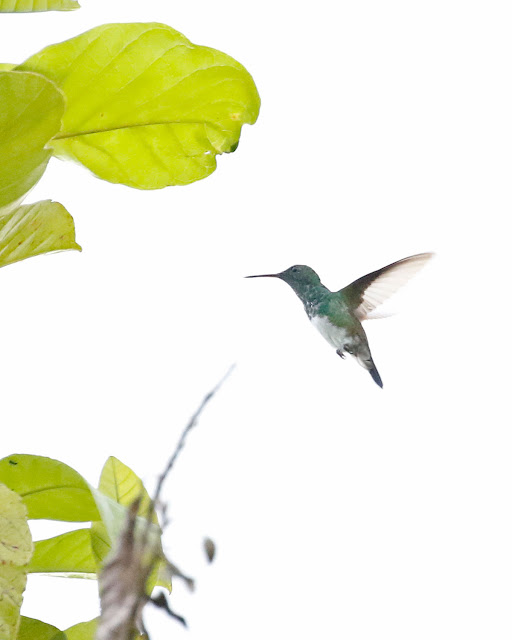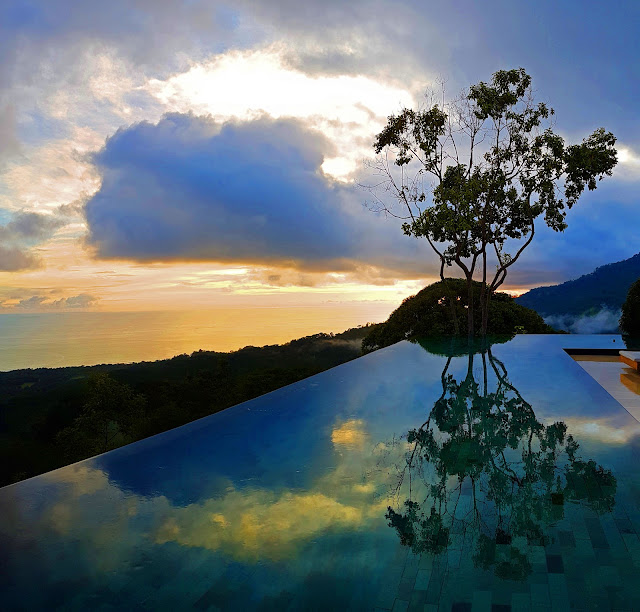We made our way to the restaurant area, and I rescued a House Wren that was trapped behind the glass balustrades. As I let it go I also noticed once again the number of crickets and praying mantis that were about.
As we headed up the stairs we were met by one of the staff and informed that our trip had been cancelled. Apparently the storm on Saturday afternoon and night had blown down many trees and all the major trails were either blocked or waterlogged. It was one of those moments when you go silent in disbelief.
To say we were disappointed was an understatement, we were looking forward to it, and had even accepted the discomfort we would face from the boat trip! It was then a case of what do we do? We asked if it would be possible to go the next day, our last day, and it was a case of then waiting to see, but I personally did not hold out much hope.
We had some time before breakfast, which we could now enjoy at our leisure, so we spent this searching around the pool area, and down into the gardens.
On the edge of the pool a Cricket appeared to be drinking.
It stayed in this position for sometime, and in the end fell over so I am not sure what was going on!.
On the glass balustrades a Praying Mantis sat. The glass provided some nice reflections and background.
On the floor were several Red-winged Giant Grasshoppers. These really are giants coming in at around 15 centimetres long. They are also quite scary when you disturb them as they fly off with totally no coordination.
Birds were now moving, and in the tree above the pool a White-fronted Parrot flew in, and sat watching and occasionally calling
As with all parrots there is the risk of local trade and birds caught and sold as pets, but the White-fronted Parrot is fairly abundant, and is thought to have benefited from agricultural expansion.
A pair of Crimson-fronted Parakeets flew over calling.
These parakeets are green overall with conspicuous red and yellow underwing
coverts, red forehead and red at the front of the lores. The Crimson-fronted Parakeet’s main habitat is forest edge
and like the White-fronted Parrot, it may actually be increasing its geographic range due to deforestation, and agricultural expansion.
It was still not warm enough for the vultures to appear, they were probably sitting in trees waiting for the sun to set off the thermals. Swifts though were very busy, passing by us a they flew around the many trees hunting for airborne insects.
The White-collared Swift.
A large, black swift with a complete white collar, the
White-collared Swift can be found in a wide range of habitats at a wide range
of altitudes,
and spends most of the day on the wing, in flocks of as
many as 200 individuals, hunting for flying insects.
These flocks may contain members of several species of
swifts, and in this case they were flying with Chestnut-collared Swifts, who like the White-collared will fly in mixed flocks
It was low tide at this time of day, and looking out to sea the Whale's Tail feature of the Marino Ballena National Park below us in Uvita was very defined.
During low tide, the water recedes to reveal a formation of rocks and sand in the form of a tail. It’s been affectionately
named the Whale Tail as it is the best humpback whale watching place in Costa
Rica. These were the best views of it we had.
Gone are the days where we would quite happily sit by the pool all day, so we decided to go for a walk in the morning before it got too hot in the forest around the hotel. We received some instructions of where we could walk, the gates were opened and we set off.
We followed the road down hill to a turn that also headed downhill. We could hear running water as we descended, and there were several Damselflies about.
As we crossed the stream we passed through an area covered by the tree canopy, and the sunlight was dappled as it came through. Above us just below the leaves several butteflies could be seen but they did not stop.
On the other side of the stream the path headed up hill, then came out into a clearing. The light and open area was surrounded by banana plants with many flowers. There was also grass which was an attraction to butterflies. The first to stop was this Blue, that looked uncannily like our own Common Blue, however I never saw the underside so identification was impossible.
There were many Julia Longwings about, flitting from almost every open flower head.
Many of the butterflies we had seen before, like this Montane Longwing.
With all the flowers and Heliconas, it was no surprise to hear hummingbirds, it was though harder to pin them down. Finally I managed to find one feeding on a heliconas, but as quickly as I found it and lifted the camera it was off.
It was a Rufous-tailed Hummingbird, the identification confirmed when I re-located it on the other side of the track
The Rufous-tailed Hummingbird is perhaps the most common
species of hummingbird at forest edge and in gardens and cultivated areas from
southern Mexico south to north-western South America.
The path then reached a fork, and we were advised not to go too far beyond here. The area though was quite open, and there were plenty of birds in the trees and bushes. We could see Tropical Kingbirds, and these flycatchers were joined by the Streaked Flycatcher.
A White-collared Seed-eater sang from within a tree, its song very reminiscent of that of a Willow Warbler.
A Green Honeycreeper did exactly what it says on the tin, and crept through the leaves.
While a tiny Bananaquit was busy in foraging in the middle of the banana plants.
The most striking bird though was the Cherrie's Tanager. Though it was classified for many years as a subspecies of Passerini's
Tanager , Cherrie’s Tanager was returned to species status in 1997, based on
genetic evidence, lack of hybridization with its sister species, and
differences in female plumage. The male plumage is a striking combination of
mostly black plumage contrasting with a scarlet-red rump patch.
Then as we decided to turn back I picked out this Black-headed Trogon which was actively preening in a tree.
We made our way back along the open path, where there were more butterflies still. A Julia Longwing in a classic pose.
Then a larger brown butterfly. I waited for it to settle.
It then opened the wings to allow identification, this is a Genoveve Buckeye.
They are known as Buckeyes due to the prominent Ocellii on the fore and hind upper wings.
The butterflies had now been joined by a few dragonflies, this one is a common species, the Blue-eyed Skimmer.
Familiar now, this Long-tailed Skipper allowed some close inspection. The hairs looking like feathers on the back of this butterfly.
Then another new butterfly, again looking skipper like It wasn't until I got home that I was able to identify it. This is a skipper, an Orchus-chequered Skipper. These are popularly called flat or spread wings after the way they will settle. Despite being known as chequered skippers they bare no relationship with the European Skippers to which it looks similar.
It is found in a wide variety of habitats including forest edges, pastures and grassland.
The walk back to the hotel saw us miss a few more hummingbirds, and many butterflies. Looking out over the ocean once again, the clouds were bubbling, and had the shape of a teddy bear.
Still not ready to settle I took some time to photograph some of the flowers around the villas.
With the heat increasing I succumbed to the pool, but with binoculars and camera never too far away. This turned out to be the right approach. The vultures were now soaring around us in good numbers, and i noticed one larger and whiter than the rest. As it soared in came above us, and came much closer. At last the King Vulture had come into an acceptable range.
It was still distant, and the photographs were not the best, but it was closer than yesterday. there was still time for that crippling fly past. It is normally found in tropical lowland forests. If you exclude the two condor species, the King Vulture is the largest new world vulture.
An imposing bird, the adult king vulture has predominantly
white plumage, which has a slight rose-yellow tinge to it. In stark contrast, the wing coverts, flight
feathers and tail are dark grey to black, as is the prominent thick neck ruff.
The vulture drifted away and was not seen again today, so much territory to scan.
Today there was to be a total eclipse visible within a band across the entire United States, passing from the Pacific to the Atlantic coasts. Outside of that area there would be a
partial solar eclipse, visible on land from Nunavut in northern Canada
to as far south as northern South America. we were in that band, and at around 13.00 local time a piece of the sun was missing. Fortunately there was cloud about, and as the sun passed through the cloud we were able to see the partial eclipse leave the sun as if a bite had been taken out of it. Not the spectacular photographs that were taken in the United States, but a record of the event.
Calls from below us announced the arrival of the pair of Chestnut-mandibled Toucans.
despite their proximity they insisted on calling loudly at each other.
Another toucan species was also present. This is the Fiery-billed Aracari. There are two Aracari species in Costa Rica, this one and the Collared. The Fiery-billed is only found on the Pacific slopes.
In the trees and bushes around the pool there was plenty of activity. The now common Blue-gray Tanager.
And the Golden-hooded Tanager, which it would seem I was only able to photograph when engaged in preening.
We had had tantalising glimpses of hummingbirds around the pool, but this evening one decided to show a lot more. This enabled me to identify it, not the Rufous-tailed we had seen earlier in the day but a White-necked Jacobin.
From the same perch it would hover around the underside of the leaves, probably picking off very small insects of spiders.
Calls were ringing out from above, behind and below us. One call involved two distinct birds and was monotonous. Helen managed to find the owners, a very long way below us. This was a major feat, as the birds themselves were almost all green and perched at the top of a tree. They are Mealy Parrots.
These are the largest of the known Amazon parrots, mostly all green they are endemic to Central and South America. They are usually quiet, but like these two can be very loud at dawn or dusk.
The signs were that this would be a good evening to watch the sunset. There was cloud but the skies were relatively clear. the reflections in the pool once more were quite spectacular.
The sun finally dipped below the clouds away to the west, and the sky turned into a fiery golden glow stretching out across the water just before it slipped away into the Pacific.
It was the perfect end to a day that started with disappointment, but we managed to make up for it. The option to visit Corcovado tomorrow was not really on, and to make up for this the hotel had arranged for us to visit a local rain forest Refuge at first light tomorrow morning. another early start on what will be our last full day.
















































No comments:
Post a Comment